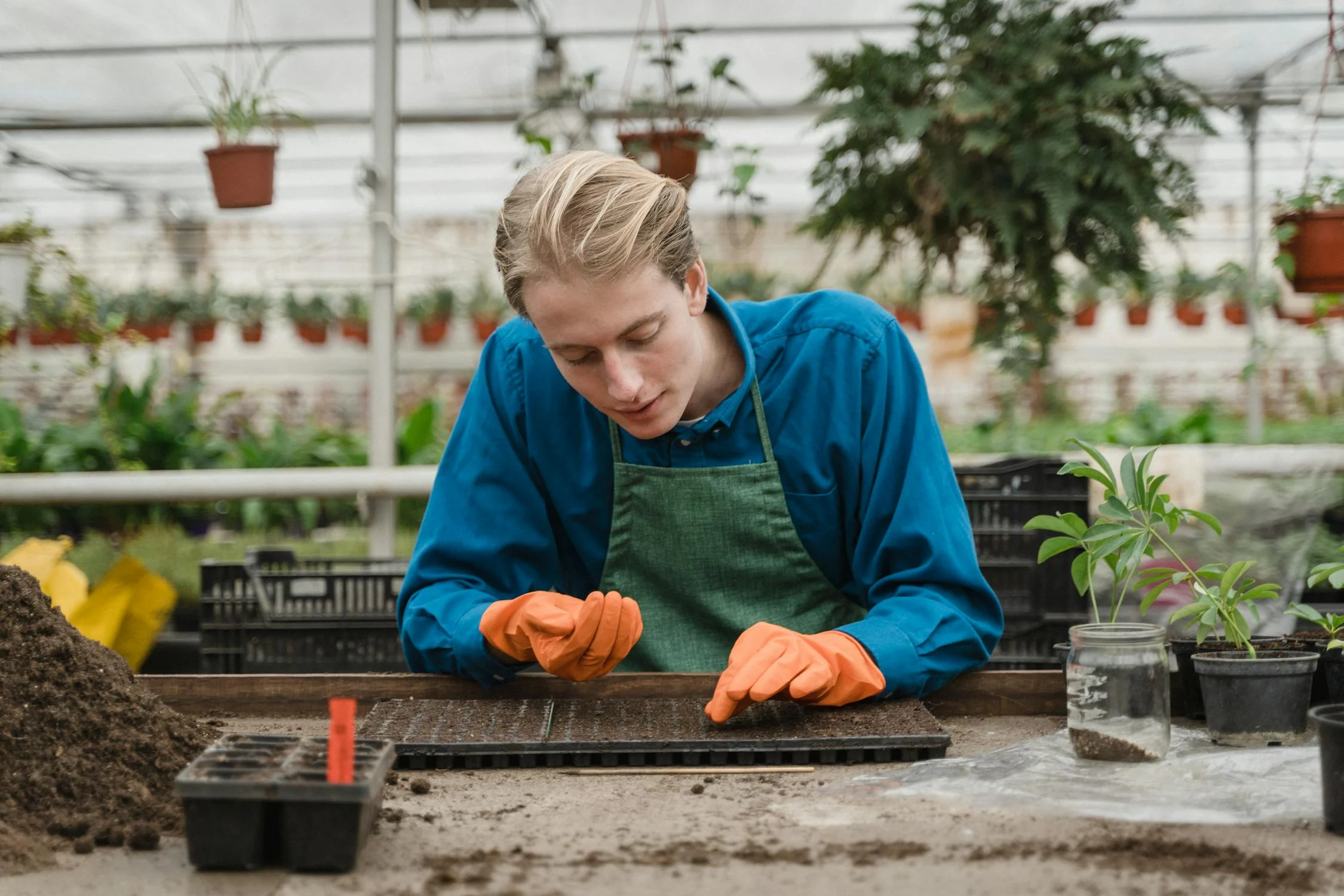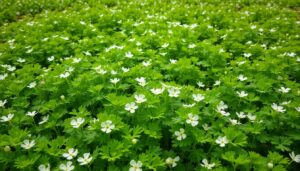Are you ready to explore the magical world of balloon flowers? These perennials can turn your garden into a vibrant landscape. They are known as platycodon grandiflorus and have unique balloon-like buds that open into stunning star-shaped flowers.
Balloon flowers are special additions to any garden. They come from Asian regions like China, Korea, Japan, and Russia. Their puffy buds swell before opening into 2 to 3-inch blossoms, making them stand out.
These plants are hardy in USDA zones 3 through 8. They are perfect for both experienced gardeners and beginners. Balloon flowers bring whimsy and color to your outdoor spaces with their unique look and easy care.
Balloon flowers have fascinating growth habits and attract pollinators like bees and butterflies. This guide will help you grow and care for these remarkable plants.
Table of Contents
Understanding Balloon Flowers and Their Origins
Balloon flowers, also known as chinese bellflower or japanese bellflower, are amazing plants with a deep history in East Asia. They have won the hearts of gardeners and botanists with their special traits and rich past.
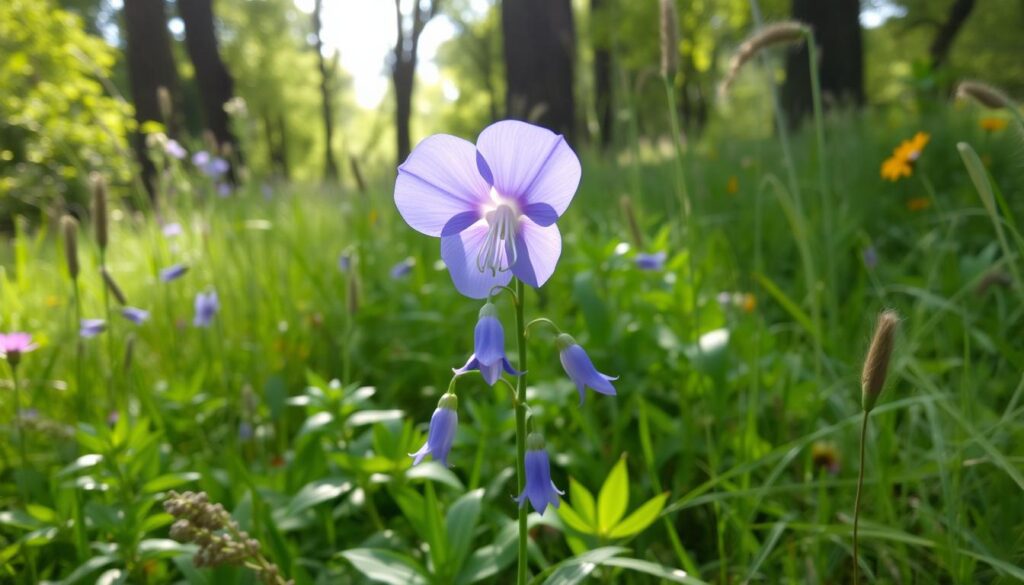
Native Habitat and Natural History
Balloon flowers come from the varied landscapes of China, Korea, Japan, and Russia. They thrive in different environments, from mountain slopes to open meadows. This shows their strong ability to adapt.
- Native regions: East Asia and Eastern Russia
- Habitat diversity: Mountains, meadows, and grasslands
- Climate adaptation: USDA hardiness zones 3-8
Botanical Characteristics
The japanese bellflower is part of the Campanulaceae family. It’s known for its balloon-shaped buds that burst into star-shaped flowers. These plants grow 1-3 feet tall, with slender stems and oval leaves.
| Characteristic | Description |
|---|---|
| Scientific Name | Platycodon grandiflorus |
| Plant Height | 1-3 feet |
| Flower Colors | Blue, Purple, White, Pink |
Cultural Significance
In Asian traditions, balloon flowers hold deep meanings. They symbolize the five elements of Taoism and play a big role in ceremonies and medicine.
“The balloon flower symbolizes endless love, honesty, and the intricate balance of natural elements.”
- Victorian flower language: Symbolizes endless love
- Traditional medicine: Used for respiratory remedies
- Culinary applications: Young leaves and roots used in Korean cuisine
Essential Growing Requirements
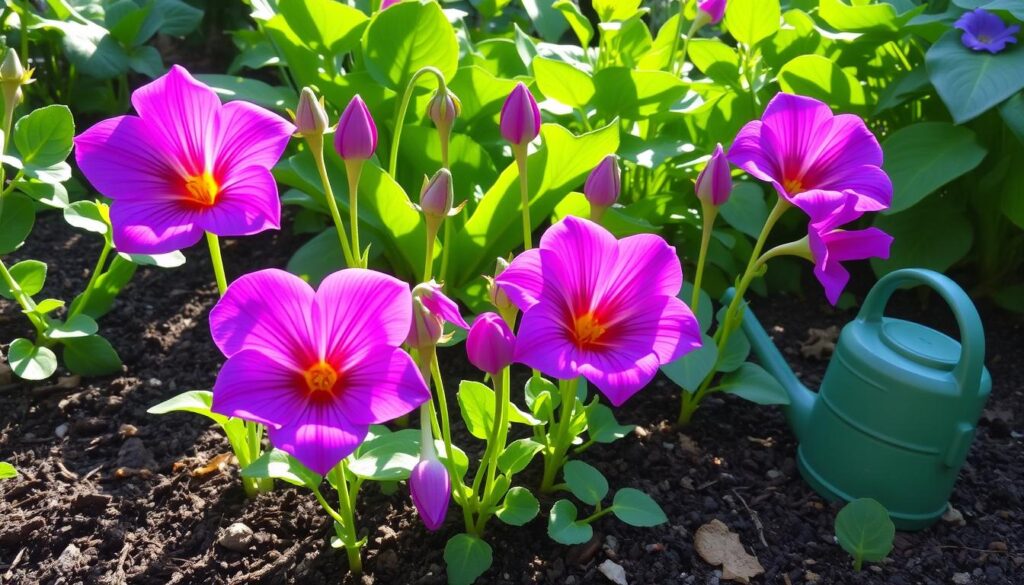
Balloon flowers are easy perennials that grow well in many gardens. They are perfect for cottage gardens because they are easy to care for. These flowers can grow in different conditions, making them great for both new and experienced gardeners.
To grow balloon flowers well, you need to know a few key things:
- Full sun exposure (6-8 hours of direct sunlight daily)
- Temperature range between 60-80 degrees Fahrenheit
- Well-draining, rich soil with pH levels between 5.5 and 7.5
- Moderate moisture levels
Plant your balloon flowers in a sunny spot that’s not too hot. They are very forgiving plants that can handle some drought. Just make sure to care for them well when they’re young.
“Balloon flowers are nature’s gift to gardeners seeking beautiful, low-maintenance perennials.” – Garden Enthusiast Magazine
For the soil, aim for something rich and loamy. These plants have a deep taproot, so make sure the soil is deep enough. Balloon flowers can grow in USDA zones 3-8, which means they can handle many climates.
As a cottage garden perennial, balloon flowers give you beautiful flowers all summer with little work. Their ability to adapt and their beauty make them a favorite among gardeners.
Light and Temperature Needs
Knowing what light and temperature your balloon flowers need is key. These plants are tough and do well in certain conditions. They need the right amount of sunlight and temperature to grow well and bloom brightly.
Optimal Sunlight Exposure
Balloon flowers love full sun to partial shade. They need 6 hours of direct sunlight every day. Place them where they get lots of light but avoid too much heat in the afternoon.
- Full sun locations with morning light are ideal
- East-facing windows provide perfect morning sunlight
- Afternoon shade helps prevent leaf burn in hot climates
Temperature Tolerance Range
Balloon flowers are very flexible with temperature. They grow best when it’s between 60°F and 80°F during the day.
| Temperature Range | Plant Response |
|---|---|
| 60°F – 80°F | Optimal Growth Conditions |
| 50°F – 60°F | Comfortable Nighttime Temperature |
| Above 80°F | Potential Heat Stress |
Climate Zone Considerations
Balloon flowers are very hardy and grow well in zones 3 to 8. Your local weather will affect how you care for them. But with the right care, they can thrive in many places.
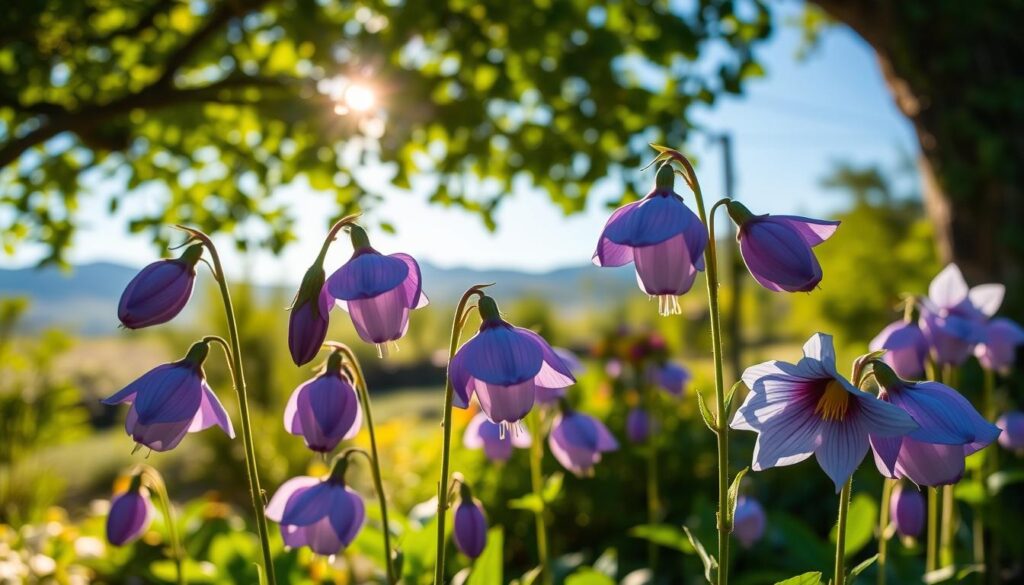
“Successful gardening is about understanding your plant’s unique environmental needs” – Professional Gardener
By giving your balloon flowers the right light and temperature, you’ll have a garden full of healthy, blooming flowers.
Soil Preparation and Requirements
Creating the perfect soil environment is key for growing balloon plants. Your plant’s health depends on the soil’s quality, drainage, and nutrients. Knowing what your soil needs will help your plants thrive.
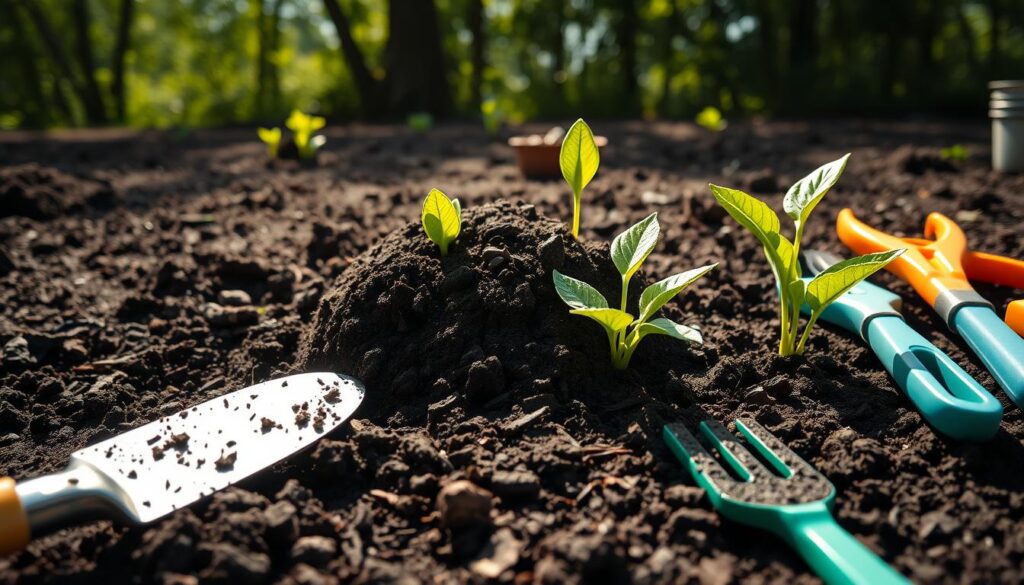
Balloon flowers need a specific soil type to grow well. Here are the main soil characteristics to aim for:
- pH range between 5.5 and 7.5
- Well-draining, loamy soil composition
- Rich in organic matter
- Light and aerated structure
To make the best soil for your balloon plant, use this mix ratio:
| Soil Component | Proportion |
|---|---|
| Garden Soil | 3 parts |
| Compost | 2 parts |
| Perlite/Coarse Sand | 1 part |
| Peat Moss | 1 part |
When preparing soil for balloon flowers, focus on drainage. Poor drainage can cause root rot and stress. Add perlite or coarse sand to improve aeration and prevent water from staying too long. Before planting, till the soil to at least 12 inches deep to help roots grow.
“Healthy soil is the foundation of a thriving garden” – Gardening Wisdom
If your soil is heavy clay, consider raising your garden bed or adding lots of amendments to improve drainage. Test your soil’s pH and adjust it with limestone to raise or sulfur to lower it as needed.
Watering Guidelines for Balloon Flowers
Growing balloon flowers needs a smart watering plan. This helps them grow well and get their big, round buds. Knowing how much water they need keeps them healthy and bright all season.
Moisture Requirements
Balloon flowers need careful watering. Young plants like their soil always a bit damp. As they grow, they can handle some dryness but still like regular water.
- Keep soil consistently moist but not waterlogged
- Water deeply during active growth in spring and summer
- Allow top inch of soil to dry between watering sessions
Watering Schedule
How often you water depends on a few things. These include the weather, soil type, and how old the plant is. If your balloon flowers are in pots, check the soil more often, especially when it’s hot.
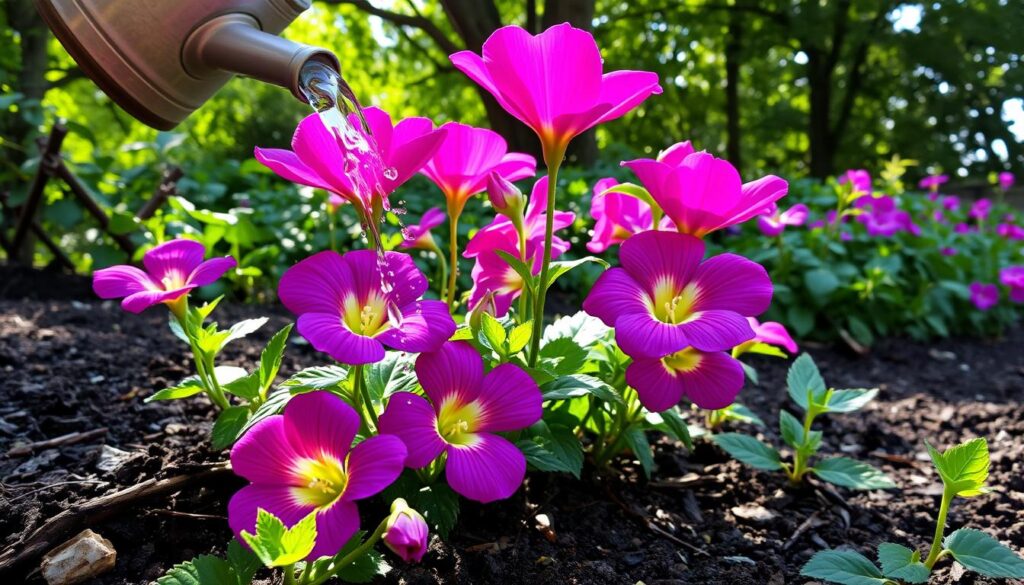
Drainage Considerations
Good drainage is key for healthy buds. Choose pots with holes and use soil that drains well. Sandy soil needs more water, while clay holds it longer.
Pro tip: Use the finger test – if soil feels dry at the second knuckle, it’s time to water!
Seasonal Watering Tips
Change your watering plan with the seasons. Water less in fall as plants get ready to sleep. In winter, zones 3-8 need very little water. Start watering more in spring to help new growth.
Popular Balloon Flower Varieties
Platycodon grandiflorus offers gardeners a stunning array of balloon flower varieties. These varieties can transform your garden with their unique charm. They add vibrant color and visual interest to your landscape.
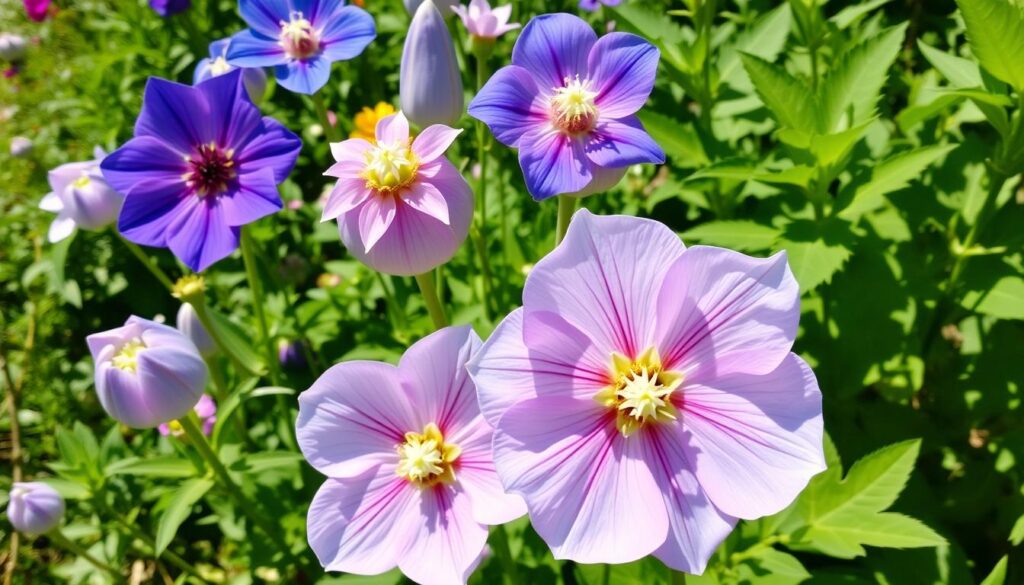
When exploring platycodon grandiflorus varieties, you’ll discover some remarkable options:
- Astra Series: Known for compact growth and prolific blooming
- Fuji Series: Featuring larger, more dramatic balloon-like buds
- ‘Komachi’: A dwarf variety perfect for smaller garden spaces
- ‘Sentimental Blue’: Produces deep blue flowers with exceptional color intensity
Each variety of platycodon grandiflorus brings unique characteristics to your garden. Some grow between 1-2 feet tall, while dwarf varieties remain under 12 inches. Blue remains the most popular color, but you’ll also find stunning pink and white options.
Pro gardening tip: Choose balloon flower varieties based on your specific garden design and climate zone for best results.
Consider these varieties for different garden scenarios:
- Containers and small spaces: Choose compact varieties like ‘Sentimental Blue’
- Mixed borders: Select taller Fuji Series for background interest
- Rock gardens: Opt for shorter, spreading cultivars
Your selection of platycodon grandiflorus will depend on your garden’s specific needs, sunlight exposure, and aesthetic preferences. With proper care, these resilient perennials will reward you with weeks of stunning summer blooms.
Planting Techniques and Timing
Planting bellflower plants needs careful thought for them to grow well and bloom brightly. The right way to plant can greatly affect your garden’s success.
Spring Planting Methods
Spring is the best time to plant bellflowers after the last frost. This timing lets them grow strong before summer’s heat. Wait until the soil is warm and there’s no risk of frost.
- Wait until soil temperatures reach 60°F
- Select a location with partial to full sun exposure
- Prepare garden beds or containers in advance
Spacing Guidelines
Spacing is key for your balloon flowers to grow well. These plants are 1 to 2 feet tall and 1 to 1.5 feet wide.
| Plant Type | Recommended Spacing |
|---|---|
| Garden Beds | 12-18 inches apart |
| Container Planting | 10-12 inches per plant |
Depth Considerations
Depth is important when planting bellflowers. Plant the crown a bit below the soil surface. This helps roots grow well.
“Proper planting depth is the foundation of a healthy balloon flower garden” – Gardening Expert
- Plant seeds 1/8 inch deep
- Transplants should be placed at the same depth as their nursery container
- Ensure good soil contact around roots
Pro tip: Balloon flowers in USDA Hardiness Zones 3-8 can successfully establish themselves with these planting techniques.
Fertilization and Feeding Schedule
Caring for your balloon flowers is all about the right fertilization. These plants don’t need a lot of food. But, giving them the right nutrients can make them bloom better.
Knowing how to fertilize is key to keeping your balloon flowers healthy. A balanced mix of nutrients, like a 10-10-10 NPK ratio, is best for these lovely plants.
Fertilization Best Practices
- Apply slow-release fertilizer once annually in early spring
- Use organic compost to enhance soil vitality
- Avoid over-fertilizing to prevent nutrient imbalances
| Fertilization Aspect | Recommendation |
|---|---|
| Optimal NPK Ratio | 10-10-10 |
| Fertilization Frequency | Once per year |
| Best Season | Early Spring |
Pro Tip: Keep an eye out for signs of too little or too much food. Yellow leaves or slow growth mean you might need to adjust. If you’ve overfed, water the soil well and wait 3-4 weeks before feeding again.
“Balanced nutrition transforms balloon flowers from good to extraordinary” – Garden Experts
With a little care, your balloon flowers will do great. Just a light feeding each year and good soil are all they need to thrive.
Maintenance and Pruning Tips
Caring for balloon flowers in your cottage garden is important. They need regular maintenance and pruning to grow well. This ensures they bloom all season long.
Deadheading Methods
Deadheading keeps your garden looking great. Here’s how to do it right:
- Remove only faded flowers, not entire stems
- Cut just below the spent bloom
- Leave remaining buds on the stem to continue opening
- Perform deadheading regularly during blooming season
Seasonal Care Strategies
Each season has its own care needs for balloon flowers:
| Season | Maintenance Action |
|---|---|
| Spring | Prune back one-third of stems to encourage fresh growth |
| Summer | Deadhead regularly, maintain consistent moisture |
| Fall | Prepare for dormancy, apply protective mulch |
| Winter | Reduce watering, protect roots with 2-4 inches of mulch |
Support Systems for Taller Varieties
Taller balloon flowers might need extra support. Here are some ideas:
- Use garden stakes for individual plants
- Install lightweight trellises
- Group plants together for mutual support
- Prune lanky stems by half in late spring
Remember, balanced pruning is key to maintaining healthy, vibrant balloon flowers in your cottage garden.
Common Pests and Diseases
To keep your balloon plant healthy, you need to watch out for pests and diseases. It’s important to know the common threats that can harm these beautiful plants.
- Aphids (up to 30% occurrence in gardens)
- Spider mites
- Mealybugs
- Scale insects
It’s key to spot pests early. Look for signs like:
- Chewed leaf edges
- Discolored foliage
- White cottony residue
- Tiny insects on leaf undersides
Fungal diseases are also a big risk. Here are some common ones:
| Disease | Symptoms | Prevention |
|---|---|---|
| Root Rot | Yellowing leaves, mushy roots | Improve drainage, avoid overwatering |
| Powdery Mildew | White powdery coating on leaves | Ensure good air circulation |
| Botrytis Gray Mold | Gray fuzzy growth on plant tissues | Remove infected plant parts |
*Preventive care can reduce pest-related damage by up to 50%*
Using natural pest control can be very effective. Introducing beneficial insects like ladybugs can cut pest numbers by 60-70%. Regularly check your plants and keep your garden clean to protect your balloon plant.
Pro tip: Keep your balloon plant in the best growing conditions. This will help it fight off pests and diseases better.
Container Growing Guidelines
Growing chinese bellflowers in containers is a great way to enjoy these plants. It’s important to choose the right container for them.
When picking a container, think about depth and drainage. The best pot is 10 to 12 inches deep for the plant’s roots. Ceramic, terracotta, or plastic pots are good, as long as they have holes for drainage.
- Select containers with minimum 10-inch depth
- Ensure multiple drainage holes
- Choose light-colored pots to prevent overheating
The right potting mix is key for success. Use a mix that drains well but holds moisture. A mix of potting soil, perlite, and compost is perfect for chinese bellflowers.
| Container Requirement | Specification |
|---|---|
| Minimum Depth | 10-12 inches |
| Drainage Holes | Multiple recommended |
| Soil Type | Well-draining organic mix |
Watering is crucial in containers. Chinese bellflowers need consistent moisture but don’t like wet soil. Water when the top inch of soil feels dry, usually every 3-4 days. Mulching helps keep the soil moist and controls temperature.
“Container gardening allows you to bring the beauty of chinese bellflowers to patios, balconies, and small spaces with careful attention to their specific needs.” – Gardening Expert
Make sure your container gets 6-8 hours of direct sunlight. In hot weather, some afternoon shade can help the plants.
Propagation Methods
There are many ways to grow more japanese bellflowers in your garden. You can use seeds, stem cuttings, or division to multiply these plants.
Seed Propagation
Getting seeds from mature japanese bellflowers takes time and care. Wait until fall when the seed pods are dry. Here’s how to do it:
- Collect mature seed pods from the plant
- Allow pods to dry thoroughly
- Carefully extract small seeds
- Store seeds in a cool, dry location
- Start seeds indoors 6-8 weeks before last frost
Stem Cutting Method
Stem cuttings are another good way to grow japanese bellflowers. Choose healthy stems from the current season, about 4-6 inches long.
- Cut stems just below a leaf node
- Remove lower leaves
- Dip cut end in rooting hormone
- Plant in well-draining potting mix
- Maintain consistent moisture
Plant Division Technique
Dividing mature japanese bellflowers is tricky because of their delicate roots. Do it in early spring, before new growth starts.
- Carefully dig around the plant’s root zone
- Gently separate root sections
- Ensure each division has healthy roots
- Replant immediately
- Water thoroughly after transplanting
“Patience is key when propagating japanese bellflowers. Not all methods guarantee instant success, but careful technique increases your chances.” – Garden Experts
Keep in mind, some methods might not give you flowering plants right away. But with the right care and conditions, your new japanese bellflowers will do well.
Conclusion
Platycodon grandiflorus is a unique and enchanting perennial for gardeners. It transforms outdoor spaces with little effort. These remarkable balloon flowers reward gardeners with stunning star-shaped blooms.
By understanding their growing needs, you can add these charming plants to various garden landscapes. They are perfect for gardeners in USDA Hardiness Zones 3-8. With the right care, they can grow 1 to 3 feet tall.
These plants thrive in 6-8 hours of sunlight and well-draining soil. Their pH levels should be between 5.5 to 7.5. Their compact growth and striking appearance are ideal for borders, rock gardens, and containers.
Success with balloon flowers requires consistent maintenance and care. Regular watering and proper mulching are key. Understanding their sunlight needs is also crucial.
By following the techniques in this guide, you can create a vibrant garden. It will showcase the beauty of Platycodon grandiflorus. Your garden will become a joyous space.
Grow these remarkable plants and watch your garden come alive. With patience and dedication, you’ll have a thriving garden. It will celebrate the natural beauty of these extraordinary perennials.
FAQ
What are balloon flowers (Platycodon grandiflorus)?
Balloon flowers are charming plants from East Asia. They have puffy buds that turn into star-shaped flowers in blue, white, or pink. They’re also called Chinese bellflowers and are loved for their unique look and easy growth.
How much sunlight do balloon flowers need?
Balloon flowers love full sun to partial shade. They do best with 6 hours of direct sunlight a day. They can handle some afternoon shade, especially in hot places.
Are balloon flowers difficult to grow?
No, they’re easy perennials for beginners and experts. They grow well in different soils with little care.
When is the best time to plant balloon flowers?
Spring is the best time to plant them after the last frost. This helps them grow strong before summer.
Do balloon flowers come back every year?
Yes, they’re perennials that come back year after year. They thrive in most USDA zones and come back in spring with care.
How often should I water balloon flowers?
Water them when the top inch of soil is dry. They like consistent moisture but not soggy soil. Water them once or twice a week, depending on your area and rain.
Can I grow balloon flowers in containers?
Absolutely! They grow well in containers. Use a mix that drains well and make sure the pot is at least 12 inches deep for their taproot.
What are the most common varieties of balloon flowers?
Popular ones include ‘Fuji Blue’, ‘Albus’ (white), ‘Komachi’ (pink), and ‘Grandiflorus’. Each has its own color and growth style.
Are balloon flowers prone to any specific pests or diseases?
They’re generally strong but can get slugs, snails, and fungal diseases. Good air, spacing, and avoiding overhead watering can help prevent these.
How do I propagate balloon flowers?
You can grow them from seeds, stem cuttings, or root division. Seeds are common, but divisions work for mature plants in early spring.

